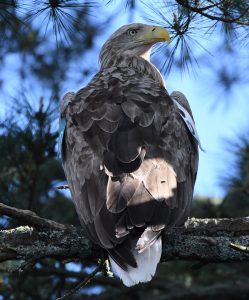
Adult white-tailed sea eagle in Glengarriff (Tim Squire).
Irish name:
Iolar mara
Description
An adult White-tailed Sea Eagle (Haliaeetus albicilla) is brown with a pale head and a distinctive white tail. It is the largest bird of prey in Ireland with a wingspan of up to 2.4m. Females are about a third larger than the males, weighing around 6kg compared to an average male of around 4kg. Juveniles are darker brown than the adults and do not develop a white tail until 3-4 years of age. White-tailed eagles can live for over twenty years.
Breeding
White-tailed Sea Eagles become sexually mature at 4-5 years old. Young birds are often wide-ranging travellers, but once paired the birds become resident within a territory. They can nest in trees, on cliffs or even on the ground but in Ireland all nests to date have been in trees. The nest or eyrie is a large edifice of sticks which both the male and female help build. The eggs are laid in March or early April, taking 35-38 days to hatch, with both adults taking on incubation duties.
For the first five weeks, the downy chick is particularly vulnerable and is incubated by the parents until it is able to regulate its own temperature. Initially the adults will feed the chicks small morsels of meat but as the chicks mature the adults drop whole items of prey in the nest and leave the chicks to feed themselves. Gradually the chicks develop dark brown flight feathers, with fledging normally occurring at 10-13 weeks. The young eaglets continue to be fed by their parents for 2-3 months until they learn to hunt for themselves and disperse from the natal area.
Diet
White-tailed sea eagles in Ireland have been recorded taking a wide range of prey, including marine & freshwater fish, waterfowl, seabirds, hares and other mammals. They also scavenge on a wide range of dead animals including seals, deer and sheep.
Present state of population
As of the end of 2017, there were 10 known breeding pairs of white-tailed sea eagles in Ireland with 21 chicks fledged to date. The pairs are spread across Cork, Kerry, Clare and Galway.
Threats
One of the major issues in Ireland has been poisoning with more than 50% percent of mortality known to be been caused by poison. Other causes of human-induced mortality have included shooting and collision with wind turbines. In terms of natural causes of death, one recently fledged bird died of starvation, one adult bird appeared to have been killed by another eagle and at least two birds have succumbed to avian flu.


